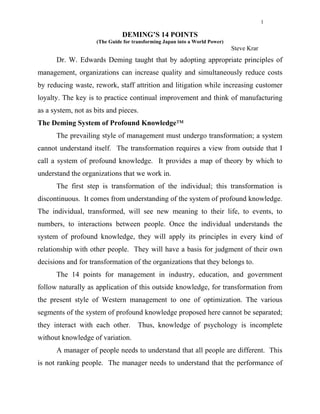
42 deming's 14 points
- 1. 1 DEMING’S 14 POINTS (The Guide for transforming Japan into a World Power) Steve Krar Dr. W. Edwards Deming taught that by adopting appropriate principles of management, organizations can increase quality and simultaneously reduce costs by reducing waste, rework, staff attrition and litigation while increasing customer loyalty. The key is to practice continual improvement and think of manufacturing as a system, not as bits and pieces. The Deming System of Profound Knowledge™ The prevailing style of management must undergo transformation; a system cannot understand itself. The transformation requires a view from outside that I call a system of profound knowledge. It provides a map of theory by which to understand the organizations that we work in. The first step is transformation of the individual; this transformation is discontinuous. It comes from understanding of the system of profound knowledge. The individual, transformed, will see new meaning to their life, to events, to numbers, to interactions between people. Once the individual understands the system of profound knowledge, they will apply its principles in every kind of relationship with other people. They will have a basis for judgment of their own decisions and for transformation of the organizations that they belongs to. The 14 points for management in industry, education, and government follow naturally as application of this outside knowledge, for transformation from the present style of Western management to one of optimization. The various segments of the system of profound knowledge proposed here cannot be separated; they interact with each other. Thus, knowledge of psychology is incomplete without knowledge of variation. A manager of people needs to understand that all people are different. This is not ranking people. The manager needs to understand that the performance of
- 2. 2 anyone is governed largely by the system that they work in, the responsibility of management. The System of Profound Knowledge™ is the basis for the application of Deming's famous 14 Points for Management: 1. Create constancy of purpose for the improvement of product and service, with the aim to become competitive, stay in business, and provide jobs. The problems of the future command first and foremost constancy of purpose and dedication to improvement to keep the company alive and to be able to provide jobs for their employees. 2. Adopt a new philosophy of cooperation (win-win) in which everybody wins and put it into practice by teaching it to employees, customers and suppliers. We can no longer tolerate commonly accepted mistakes, defects, wrong material or people on the job for which they are not suited. 3. Cease dependence on mass inspection to achieve quality. Instead, improve the process and build quality into the product in the first place. Inspection to improve quality is too late after the product has been manufactured. 4. End the practice of awarding business on the basis of price tag alone. Instead, minimize total cost in the long run. Move toward a single supplier for any one item, based on a long-term relationship of loyalty and trust. 5. Improve constantly, and forever, the system of production, service, planning, of any activity. This will improve quality and productivity and thus constantly decrease costs. 6. Institute training for skills: Management needs training to learn about the company, all the way from incoming material and the steps it goes through before the finished product is shipped to the customer. 7. Adopt and institute leadership for the management of people, recognizing their different abilities, capabilities, and aspiration. The aim of
- 3. 3 leadership should be to help people, machines, and gadgets do a better job. Leadership of management is in need of overhaul, as well as leadership of production workers. 8. Drive out fear and build trust so that everyone can work more effectively. No one can put in their best performance unless they feel secure. Secure means without fear, not afraid to express ideas, not afraid to ask questions. 9. Break down barriers between departments. Abolish competition and build a win-win system of cooperation within the organization. People in research, design, sales, and production must work as a team to foresee problems of production and use that might be encountered with the product or service. 10. Eliminate slogans, exhortations, and targets asking for zero defects or new levels of productivity. Such displays only create adversarial relationships, as the bulk of the causes of low quality and low productivity belong to the system and thus lie beyond the power of the work force. 11. Eliminate numerical goals, numerical quotas and management by objectives; substitute leadership. Work standards, rates, incentive pay and piecework are signs of the inability to understand and provide appropriate supervision. 12. Remove barriers that rob people of joy in their work. This will mean abolishing the annual rating or merit system that ranks people and creates competition and conflict. 13. Institute a vigorous program of education and self-improvement. People require in their work more than just money, they must be given the opportunity for ever-broadening opportunities toad something to society, materially and otherwise. 14. Put everybody in the company to work to accomplish the transformation. Management in authority will take pride in their adoption of the new philosophy and their responsibilities. The transformation is everybody's job.